Comparative Analysis of Economic Growth: Nigeria, China, and Policies
VerifiedAdded on 2023/03/23
|11
|1714
|46
Essay
AI Summary
This essay provides a comparative analysis of economic growth and sustainable development between Nigeria (a poor country) and China (a rich country). It uses various economic theories, including the Solow model, Malthusian Theory, and Endogenous Growth Theory, to explain the differences in GDP per capita. The essay examines factors such as capital, population, technology, quality of labor, governance, and openness, using data from the World Bank to illustrate these points. It highlights how China's higher investment in capital, technology, and education contributes to its stronger economic performance compared to Nigeria. The essay concludes with policy recommendations for Nigeria, focusing on tackling corruption, reducing trade restrictions, and increasing investment in education and health to improve the quality of labor and foster economic growth. The analysis is supported by references to academic literature and data sources.

Economic Growth And Sustainable
Development
Development
Paraphrase This Document
Need a fresh take? Get an instant paraphrase of this document with our AI Paraphraser
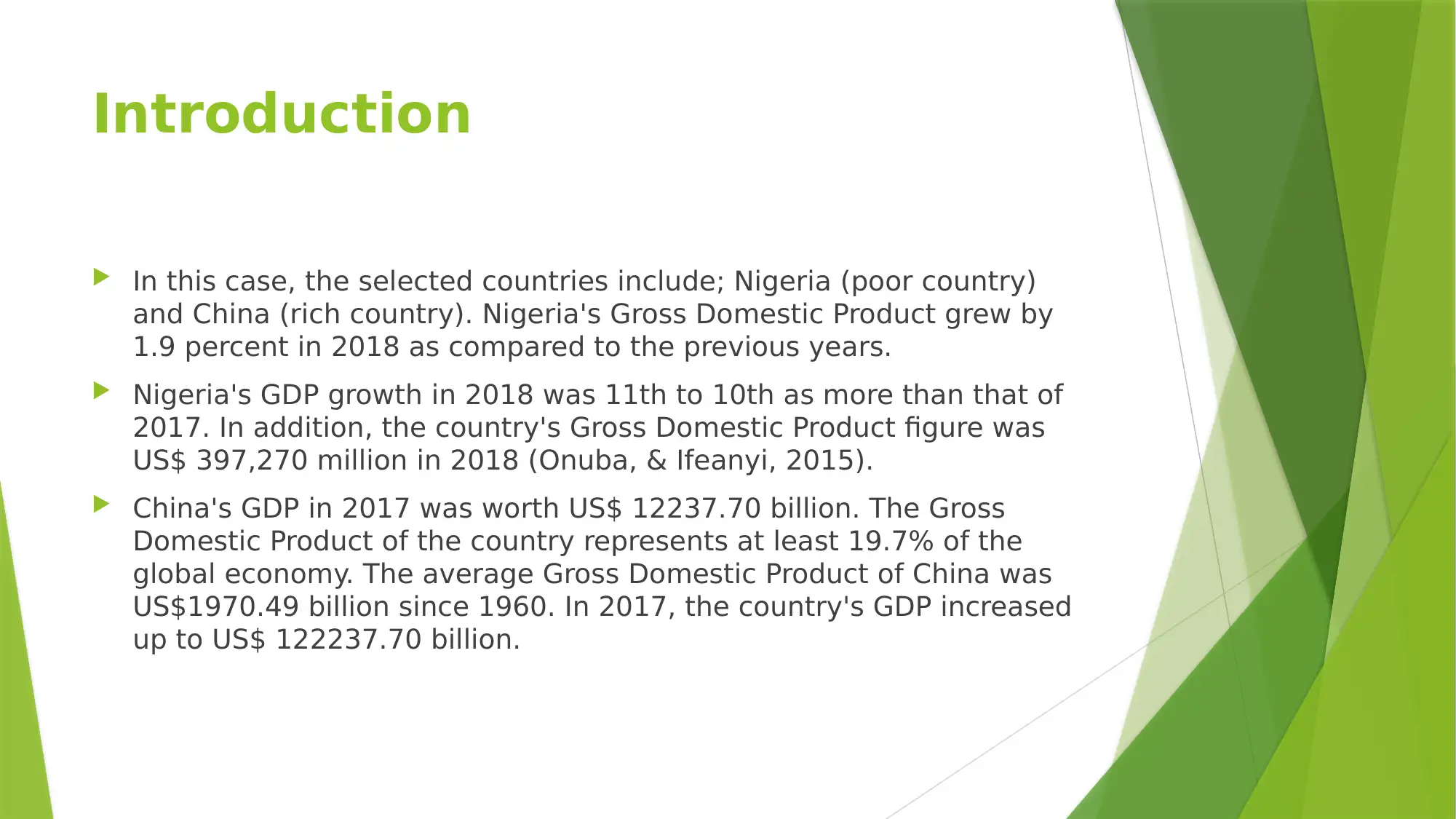
Introduction
In this case, the selected countries include; Nigeria (poor country)
and China (rich country). Nigeria's Gross Domestic Product grew by
1.9 percent in 2018 as compared to the previous years.
Nigeria's GDP growth in 2018 was 11th to 10th as more than that of
2017. In addition, the country's Gross Domestic Product figure was
US$ 397,270 million in 2018 (Onuba, & Ifeanyi, 2015).
China's GDP in 2017 was worth US$ 12237.70 billion. The Gross
Domestic Product of the country represents at least 19.7% of the
global economy. The average Gross Domestic Product of China was
US$1970.49 billion since 1960. In 2017, the country's GDP increased
up to US$ 122237.70 billion.
In this case, the selected countries include; Nigeria (poor country)
and China (rich country). Nigeria's Gross Domestic Product grew by
1.9 percent in 2018 as compared to the previous years.
Nigeria's GDP growth in 2018 was 11th to 10th as more than that of
2017. In addition, the country's Gross Domestic Product figure was
US$ 397,270 million in 2018 (Onuba, & Ifeanyi, 2015).
China's GDP in 2017 was worth US$ 12237.70 billion. The Gross
Domestic Product of the country represents at least 19.7% of the
global economy. The average Gross Domestic Product of China was
US$1970.49 billion since 1960. In 2017, the country's GDP increased
up to US$ 122237.70 billion.
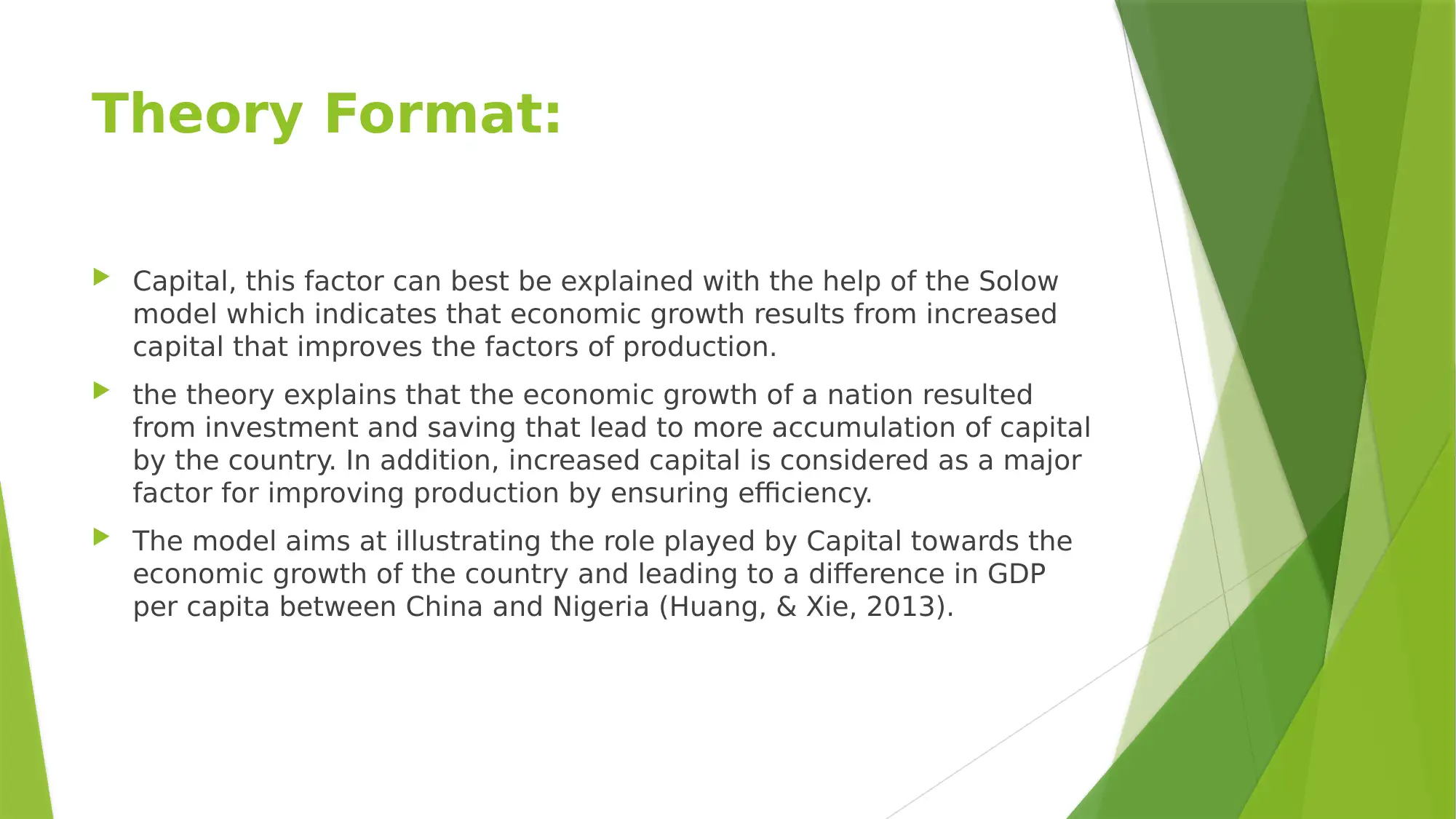
Theory Format:
Capital, this factor can best be explained with the help of the Solow
model which indicates that economic growth results from increased
capital that improves the factors of production.
the theory explains that the economic growth of a nation resulted
from investment and saving that lead to more accumulation of capital
by the country. In addition, increased capital is considered as a major
factor for improving production by ensuring efficiency.
The model aims at illustrating the role played by Capital towards the
economic growth of the country and leading to a difference in GDP
per capita between China and Nigeria (Huang, & Xie, 2013).
Capital, this factor can best be explained with the help of the Solow
model which indicates that economic growth results from increased
capital that improves the factors of production.
the theory explains that the economic growth of a nation resulted
from investment and saving that lead to more accumulation of capital
by the country. In addition, increased capital is considered as a major
factor for improving production by ensuring efficiency.
The model aims at illustrating the role played by Capital towards the
economic growth of the country and leading to a difference in GDP
per capita between China and Nigeria (Huang, & Xie, 2013).
⊘ This is a preview!⊘
Do you want full access?
Subscribe today to unlock all pages.

Trusted by 1+ million students worldwide
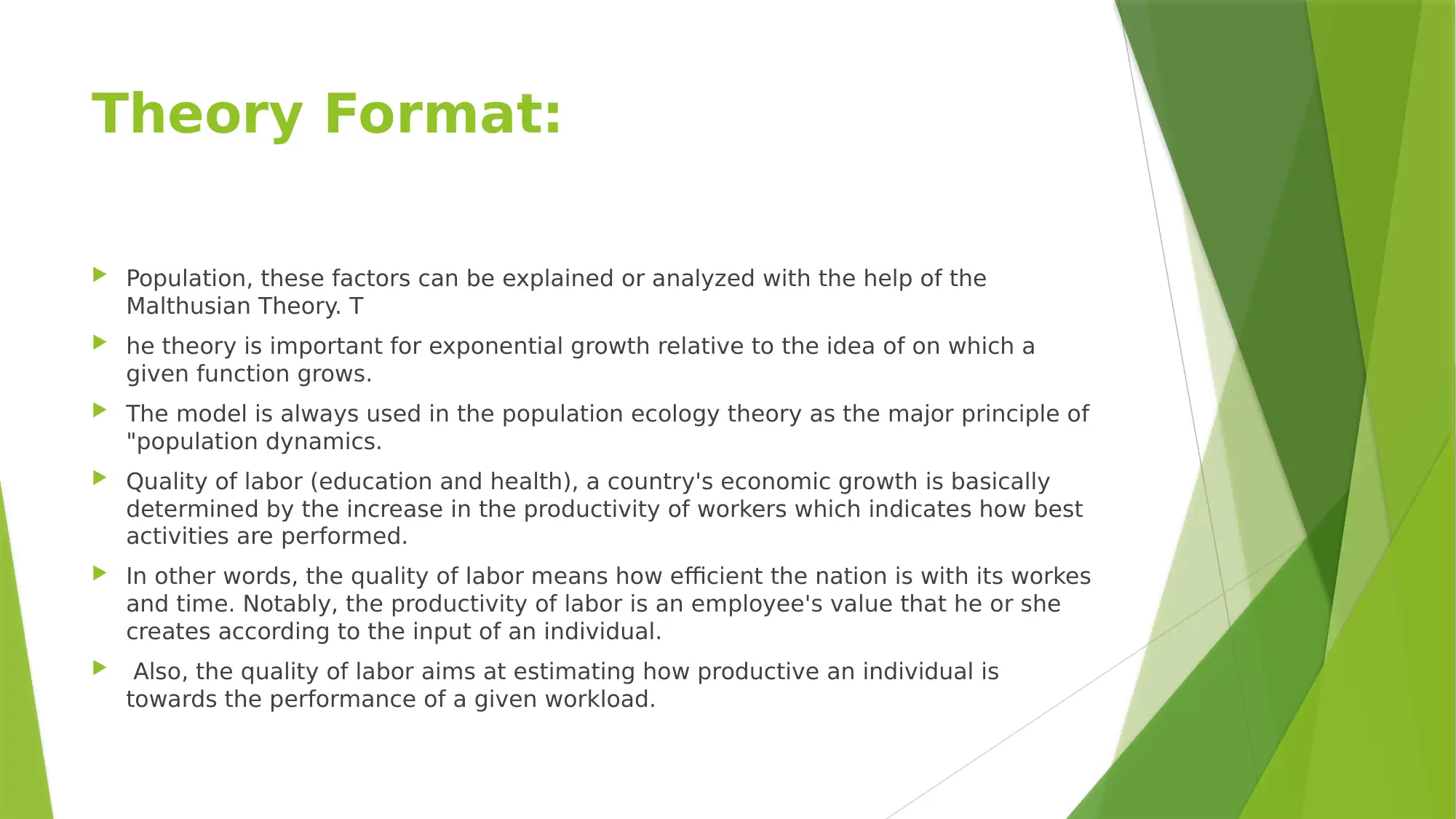
Theory Format:
Population, these factors can be explained or analyzed with the help of the
Malthusian Theory. T
he theory is important for exponential growth relative to the idea of on which a
given function grows.
The model is always used in the population ecology theory as the major principle of
"population dynamics.
Quality of labor (education and health), a country's economic growth is basically
determined by the increase in the productivity of workers which indicates how best
activities are performed.
In other words, the quality of labor means how efficient the nation is with its workes
and time. Notably, the productivity of labor is an employee's value that he or she
creates according to the input of an individual.
Also, the quality of labor aims at estimating how productive an individual is
towards the performance of a given workload.
Population, these factors can be explained or analyzed with the help of the
Malthusian Theory. T
he theory is important for exponential growth relative to the idea of on which a
given function grows.
The model is always used in the population ecology theory as the major principle of
"population dynamics.
Quality of labor (education and health), a country's economic growth is basically
determined by the increase in the productivity of workers which indicates how best
activities are performed.
In other words, the quality of labor means how efficient the nation is with its workes
and time. Notably, the productivity of labor is an employee's value that he or she
creates according to the input of an individual.
Also, the quality of labor aims at estimating how productive an individual is
towards the performance of a given workload.
Paraphrase This Document
Need a fresh take? Get an instant paraphrase of this document with our AI Paraphraser

Theory Format:
Technology, this is a big factor to economic growth and GDP per
capita within different countries.
According to the Engogenous growth theory, a country's rate of
economic growth is strongly determined or fostered by technological
innovations and human capital.
The theory illustrates that if workers have greater education, training,
and knowledge, they will be in the position to increase the rate of
technological innovation.
Further, the theory illustrates that governments should actively
rcourage different firms to consider technological innovation so as to
improve production.
Technology, this is a big factor to economic growth and GDP per
capita within different countries.
According to the Engogenous growth theory, a country's rate of
economic growth is strongly determined or fostered by technological
innovations and human capital.
The theory illustrates that if workers have greater education, training,
and knowledge, they will be in the position to increase the rate of
technological innovation.
Further, the theory illustrates that governments should actively
rcourage different firms to consider technological innovation so as to
improve production.
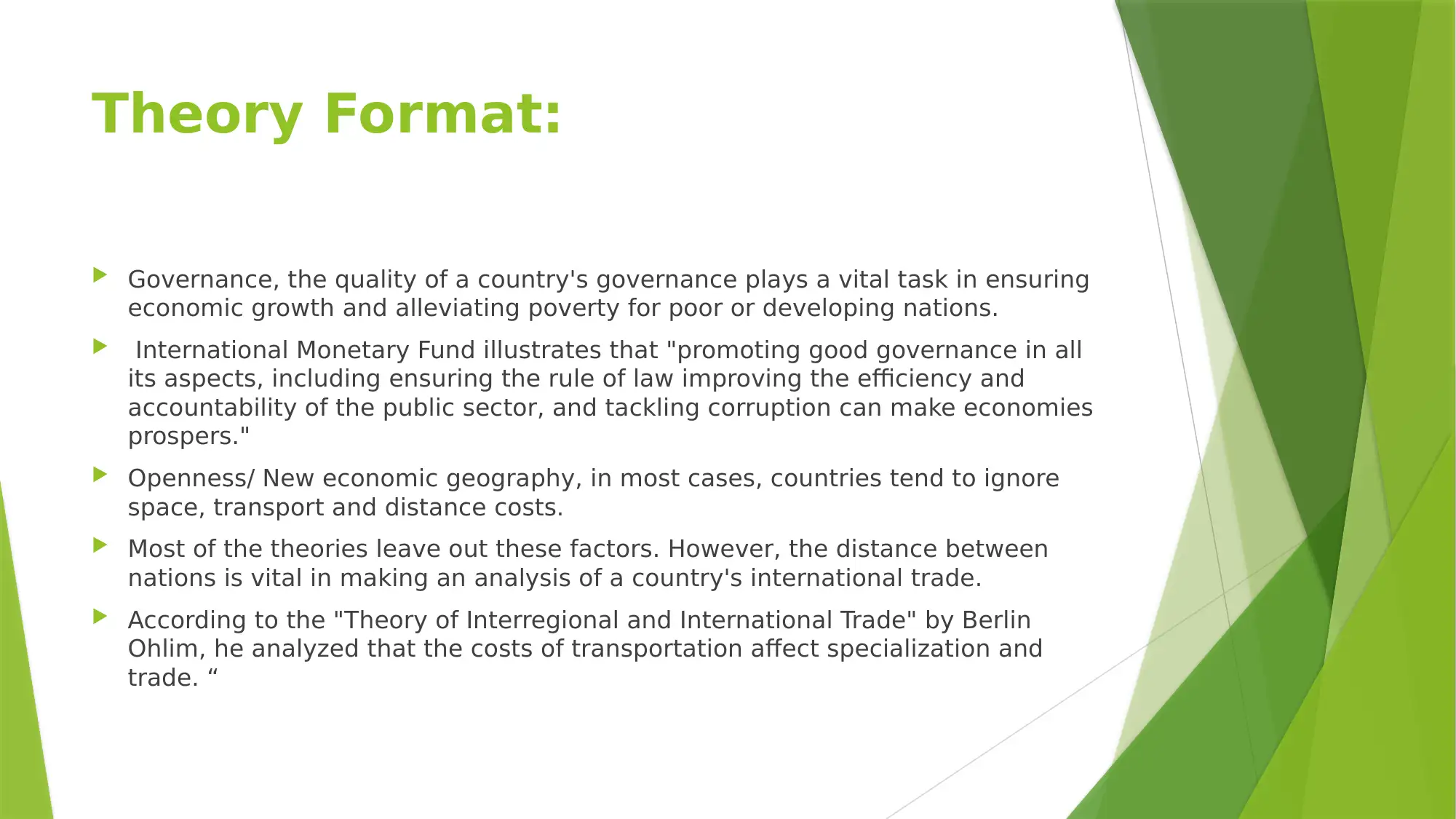
Theory Format:
Governance, the quality of a country's governance plays a vital task in ensuring
economic growth and alleviating poverty for poor or developing nations.
International Monetary Fund illustrates that "promoting good governance in all
its aspects, including ensuring the rule of law improving the efficiency and
accountability of the public sector, and tackling corruption can make economies
prospers."
Openness/ New economic geography, in most cases, countries tend to ignore
space, transport and distance costs.
Most of the theories leave out these factors. However, the distance between
nations is vital in making an analysis of a country's international trade.
According to the "Theory of Interregional and International Trade" by Berlin
Ohlim, he analyzed that the costs of transportation affect specialization and
trade. “
Governance, the quality of a country's governance plays a vital task in ensuring
economic growth and alleviating poverty for poor or developing nations.
International Monetary Fund illustrates that "promoting good governance in all
its aspects, including ensuring the rule of law improving the efficiency and
accountability of the public sector, and tackling corruption can make economies
prospers."
Openness/ New economic geography, in most cases, countries tend to ignore
space, transport and distance costs.
Most of the theories leave out these factors. However, the distance between
nations is vital in making an analysis of a country's international trade.
According to the "Theory of Interregional and International Trade" by Berlin
Ohlim, he analyzed that the costs of transportation affect specialization and
trade. “
⊘ This is a preview!⊘
Do you want full access?
Subscribe today to unlock all pages.

Trusted by 1+ million students worldwide
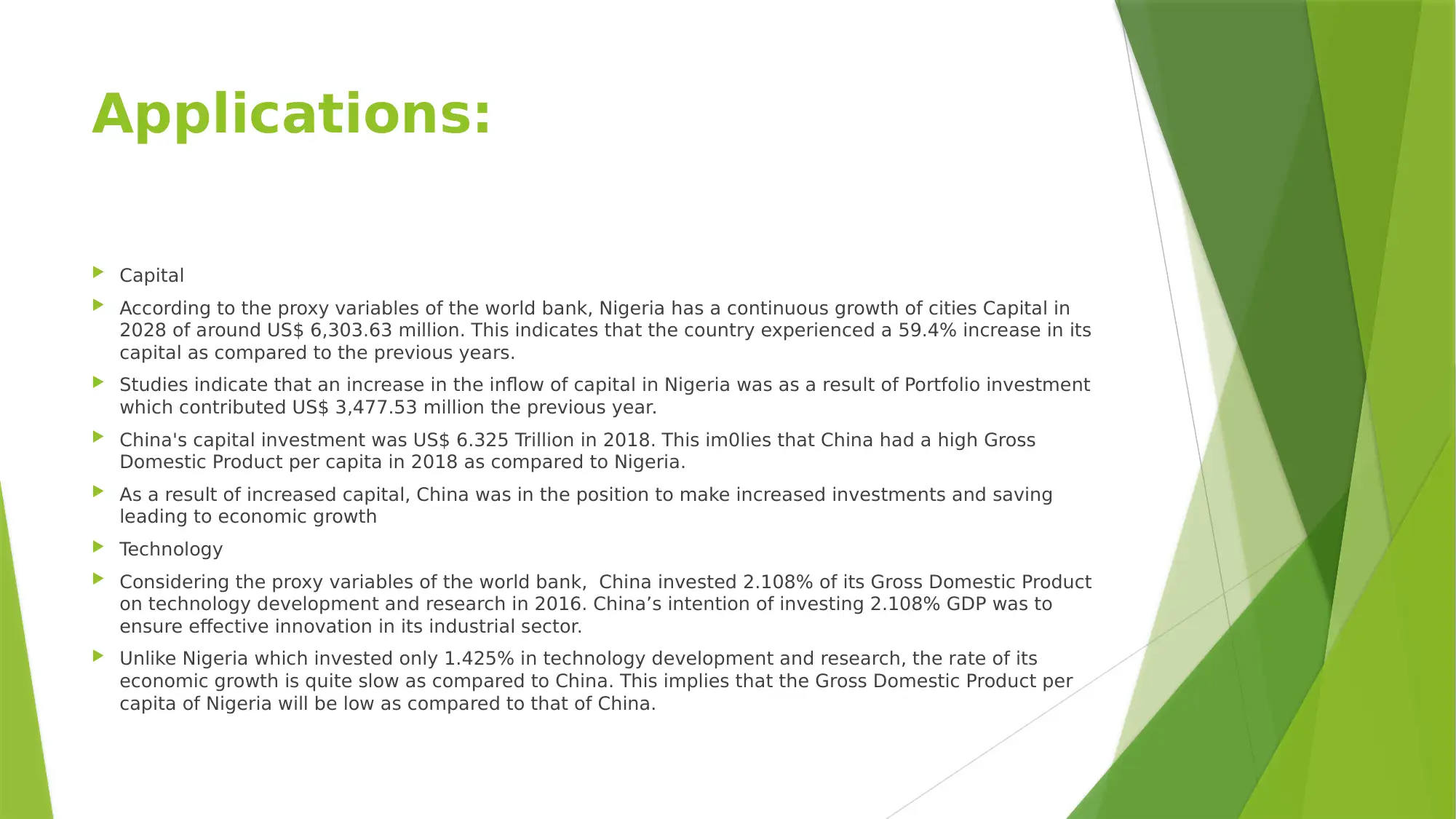
Applications:
Capital
According to the proxy variables of the world bank, Nigeria has a continuous growth of cities Capital in
2028 of around US$ 6,303.63 million. This indicates that the country experienced a 59.4% increase in its
capital as compared to the previous years.
Studies indicate that an increase in the inflow of capital in Nigeria was as a result of Portfolio investment
which contributed US$ 3,477.53 million the previous year.
China's capital investment was US$ 6.325 Trillion in 2018. This im0lies that China had a high Gross
Domestic Product per capita in 2018 as compared to Nigeria.
As a result of increased capital, China was in the position to make increased investments and saving
leading to economic growth
Technology
Considering the proxy variables of the world bank, China invested 2.108% of its Gross Domestic Product
on technology development and research in 2016. China’s intention of investing 2.108% GDP was to
ensure effective innovation in its industrial sector.
Unlike Nigeria which invested only 1.425% in technology development and research, the rate of its
economic growth is quite slow as compared to China. This implies that the Gross Domestic Product per
capita of Nigeria will be low as compared to that of China.
Capital
According to the proxy variables of the world bank, Nigeria has a continuous growth of cities Capital in
2028 of around US$ 6,303.63 million. This indicates that the country experienced a 59.4% increase in its
capital as compared to the previous years.
Studies indicate that an increase in the inflow of capital in Nigeria was as a result of Portfolio investment
which contributed US$ 3,477.53 million the previous year.
China's capital investment was US$ 6.325 Trillion in 2018. This im0lies that China had a high Gross
Domestic Product per capita in 2018 as compared to Nigeria.
As a result of increased capital, China was in the position to make increased investments and saving
leading to economic growth
Technology
Considering the proxy variables of the world bank, China invested 2.108% of its Gross Domestic Product
on technology development and research in 2016. China’s intention of investing 2.108% GDP was to
ensure effective innovation in its industrial sector.
Unlike Nigeria which invested only 1.425% in technology development and research, the rate of its
economic growth is quite slow as compared to China. This implies that the Gross Domestic Product per
capita of Nigeria will be low as compared to that of China.
Paraphrase This Document
Need a fresh take? Get an instant paraphrase of this document with our AI Paraphraser
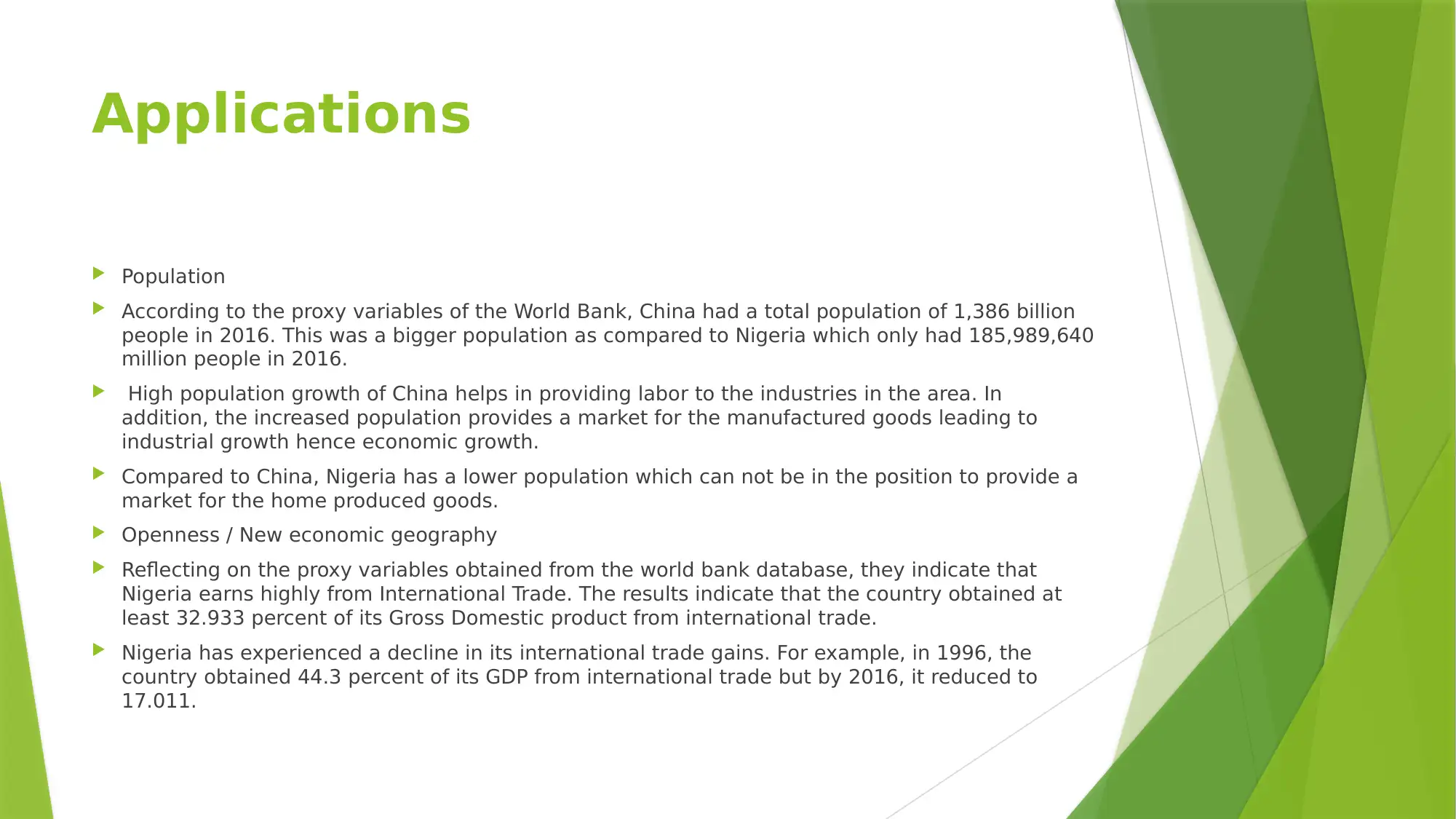
Applications
Population
According to the proxy variables of the World Bank, China had a total population of 1,386 billion
people in 2016. This was a bigger population as compared to Nigeria which only had 185,989,640
million people in 2016.
High population growth of China helps in providing labor to the industries in the area. In
addition, the increased population provides a market for the manufactured goods leading to
industrial growth hence economic growth.
Compared to China, Nigeria has a lower population which can not be in the position to provide a
market for the home produced goods.
Openness / New economic geography
Reflecting on the proxy variables obtained from the world bank database, they indicate that
Nigeria earns highly from International Trade. The results indicate that the country obtained at
least 32.933 percent of its Gross Domestic product from international trade.
Nigeria has experienced a decline in its international trade gains. For example, in 1996, the
country obtained 44.3 percent of its GDP from international trade but by 2016, it reduced to
17.011.
Population
According to the proxy variables of the World Bank, China had a total population of 1,386 billion
people in 2016. This was a bigger population as compared to Nigeria which only had 185,989,640
million people in 2016.
High population growth of China helps in providing labor to the industries in the area. In
addition, the increased population provides a market for the manufactured goods leading to
industrial growth hence economic growth.
Compared to China, Nigeria has a lower population which can not be in the position to provide a
market for the home produced goods.
Openness / New economic geography
Reflecting on the proxy variables obtained from the world bank database, they indicate that
Nigeria earns highly from International Trade. The results indicate that the country obtained at
least 32.933 percent of its Gross Domestic product from international trade.
Nigeria has experienced a decline in its international trade gains. For example, in 1996, the
country obtained 44.3 percent of its GDP from international trade but by 2016, it reduced to
17.011.
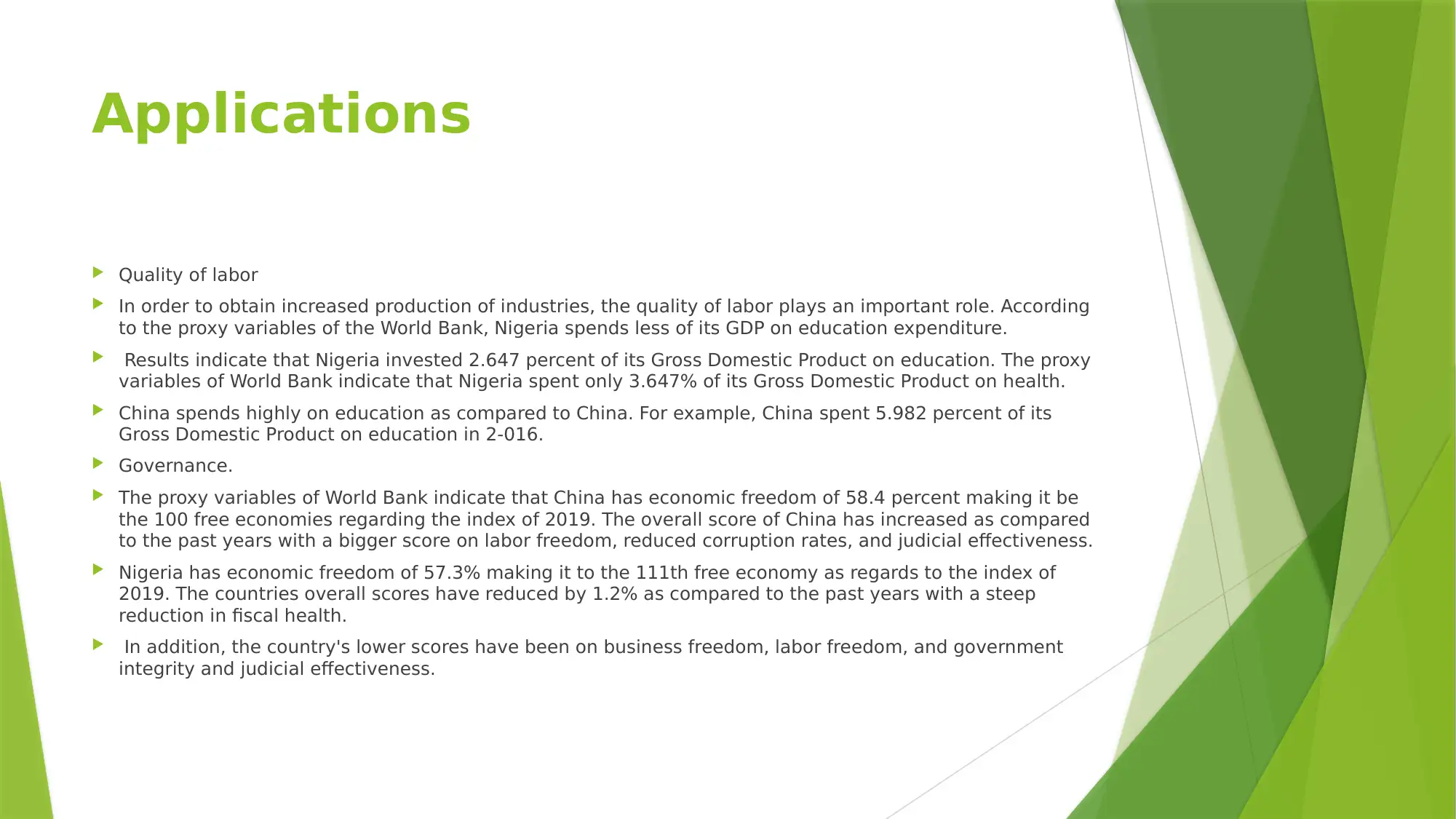
Applications
Quality of labor
In order to obtain increased production of industries, the quality of labor plays an important role. According
to the proxy variables of the World Bank, Nigeria spends less of its GDP on education expenditure.
Results indicate that Nigeria invested 2.647 percent of its Gross Domestic Product on education. The proxy
variables of World Bank indicate that Nigeria spent only 3.647% of its Gross Domestic Product on health.
China spends highly on education as compared to China. For example, China spent 5.982 percent of its
Gross Domestic Product on education in 2-016.
Governance.
The proxy variables of World Bank indicate that China has economic freedom of 58.4 percent making it be
the 100 free economies regarding the index of 2019. The overall score of China has increased as compared
to the past years with a bigger score on labor freedom, reduced corruption rates, and judicial effectiveness.
Nigeria has economic freedom of 57.3% making it to the 111th free economy as regards to the index of
2019. The countries overall scores have reduced by 1.2% as compared to the past years with a steep
reduction in fiscal health.
In addition, the country's lower scores have been on business freedom, labor freedom, and government
integrity and judicial effectiveness.
Quality of labor
In order to obtain increased production of industries, the quality of labor plays an important role. According
to the proxy variables of the World Bank, Nigeria spends less of its GDP on education expenditure.
Results indicate that Nigeria invested 2.647 percent of its Gross Domestic Product on education. The proxy
variables of World Bank indicate that Nigeria spent only 3.647% of its Gross Domestic Product on health.
China spends highly on education as compared to China. For example, China spent 5.982 percent of its
Gross Domestic Product on education in 2-016.
Governance.
The proxy variables of World Bank indicate that China has economic freedom of 58.4 percent making it be
the 100 free economies regarding the index of 2019. The overall score of China has increased as compared
to the past years with a bigger score on labor freedom, reduced corruption rates, and judicial effectiveness.
Nigeria has economic freedom of 57.3% making it to the 111th free economy as regards to the index of
2019. The countries overall scores have reduced by 1.2% as compared to the past years with a steep
reduction in fiscal health.
In addition, the country's lower scores have been on business freedom, labor freedom, and government
integrity and judicial effectiveness.
⊘ This is a preview!⊘
Do you want full access?
Subscribe today to unlock all pages.

Trusted by 1+ million students worldwide
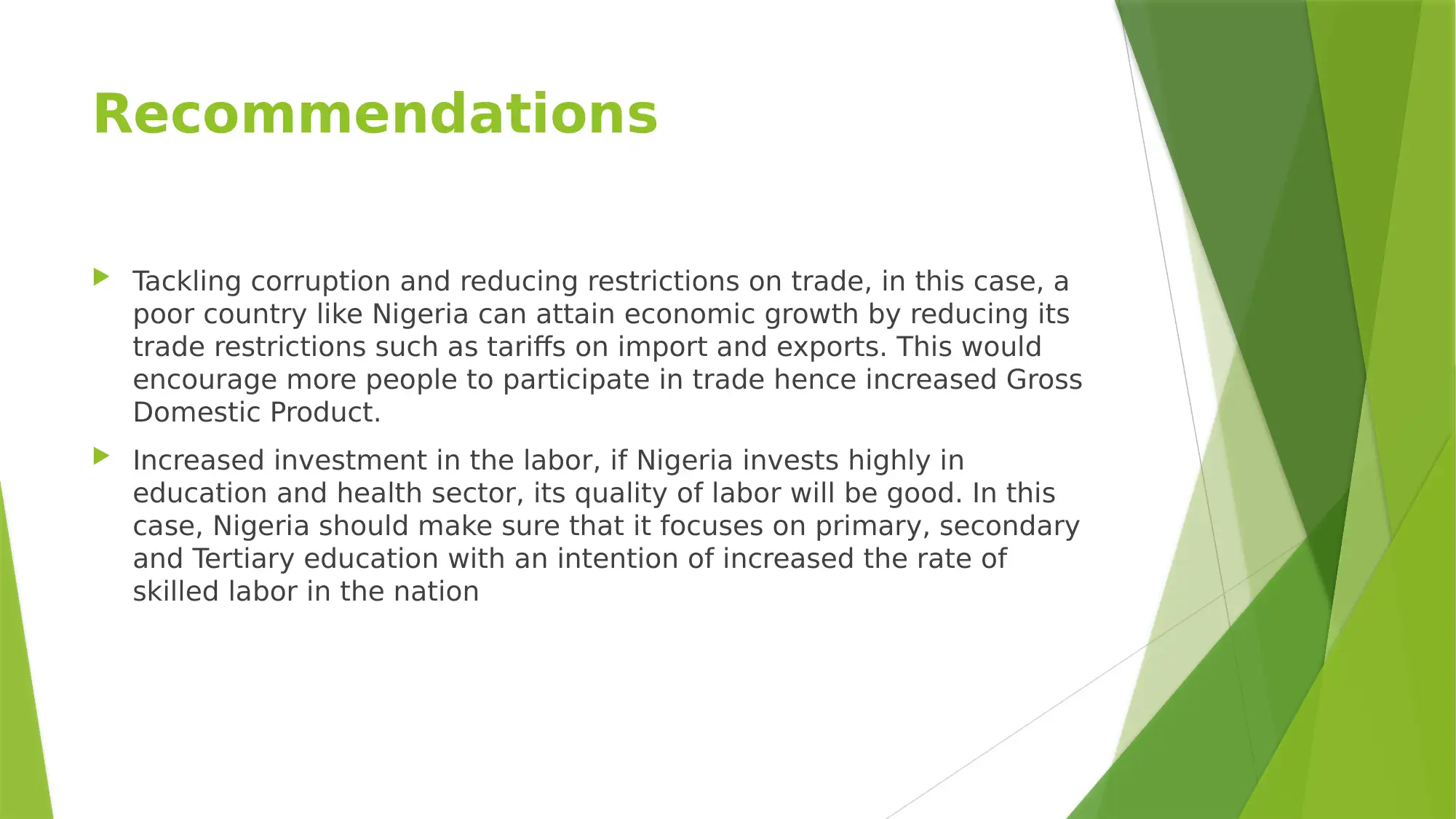
Recommendations
Tackling corruption and reducing restrictions on trade, in this case, a
poor country like Nigeria can attain economic growth by reducing its
trade restrictions such as tariffs on import and exports. This would
encourage more people to participate in trade hence increased Gross
Domestic Product.
Increased investment in the labor, if Nigeria invests highly in
education and health sector, its quality of labor will be good. In this
case, Nigeria should make sure that it focuses on primary, secondary
and Tertiary education with an intention of increased the rate of
skilled labor in the nation
Tackling corruption and reducing restrictions on trade, in this case, a
poor country like Nigeria can attain economic growth by reducing its
trade restrictions such as tariffs on import and exports. This would
encourage more people to participate in trade hence increased Gross
Domestic Product.
Increased investment in the labor, if Nigeria invests highly in
education and health sector, its quality of labor will be good. In this
case, Nigeria should make sure that it focuses on primary, secondary
and Tertiary education with an intention of increased the rate of
skilled labor in the nation
Paraphrase This Document
Need a fresh take? Get an instant paraphrase of this document with our AI Paraphraser
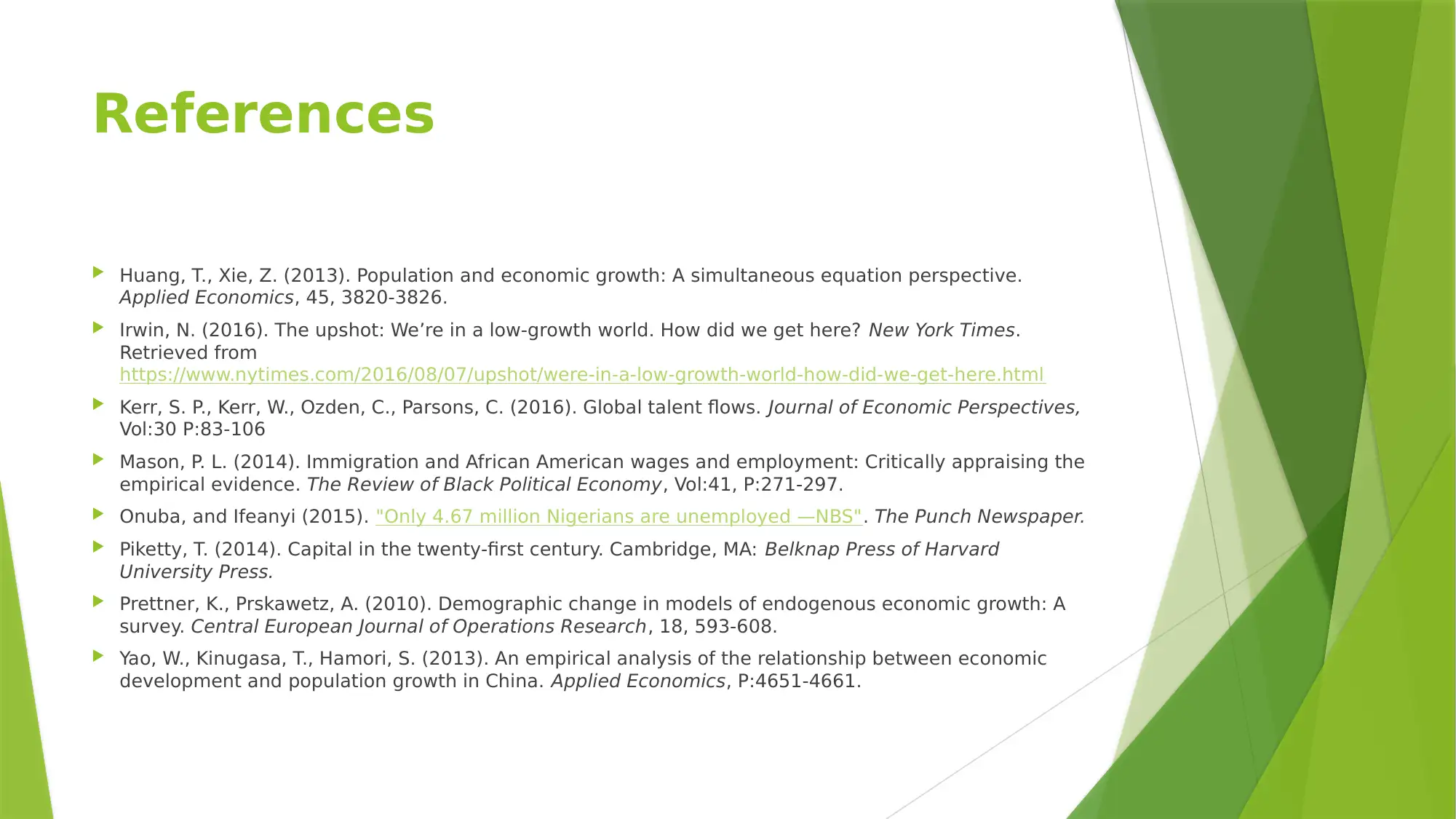
References
Huang, T., Xie, Z. (2013). Population and economic growth: A simultaneous equation perspective.
Applied Economics, 45, 3820-3826.
Irwin, N. (2016). The upshot: We’re in a low-growth world. How did we get here? New York Times.
Retrieved from
https://www.nytimes.com/2016/08/07/upshot/were-in-a-low-growth-world-how-did-we-get-here.html
Kerr, S. P., Kerr, W., Ozden, C., Parsons, C. (2016). Global talent flows. Journal of Economic Perspectives,
Vol:30 P:83-106
Mason, P. L. (2014). Immigration and African American wages and employment: Critically appraising the
empirical evidence. The Review of Black Political Economy, Vol:41, P:271-297.
Onuba, and Ifeanyi (2015). "Only 4.67 million Nigerians are unemployed —NBS". The Punch Newspaper.
Piketty, T. (2014). Capital in the twenty-first century. Cambridge, MA: Belknap Press of Harvard
University Press.
Prettner, K., Prskawetz, A. (2010). Demographic change in models of endogenous economic growth: A
survey. Central European Journal of Operations Research, 18, 593-608.
Yao, W., Kinugasa, T., Hamori, S. (2013). An empirical analysis of the relationship between economic
development and population growth in China. Applied Economics, P:4651-4661.
Huang, T., Xie, Z. (2013). Population and economic growth: A simultaneous equation perspective.
Applied Economics, 45, 3820-3826.
Irwin, N. (2016). The upshot: We’re in a low-growth world. How did we get here? New York Times.
Retrieved from
https://www.nytimes.com/2016/08/07/upshot/were-in-a-low-growth-world-how-did-we-get-here.html
Kerr, S. P., Kerr, W., Ozden, C., Parsons, C. (2016). Global talent flows. Journal of Economic Perspectives,
Vol:30 P:83-106
Mason, P. L. (2014). Immigration and African American wages and employment: Critically appraising the
empirical evidence. The Review of Black Political Economy, Vol:41, P:271-297.
Onuba, and Ifeanyi (2015). "Only 4.67 million Nigerians are unemployed —NBS". The Punch Newspaper.
Piketty, T. (2014). Capital in the twenty-first century. Cambridge, MA: Belknap Press of Harvard
University Press.
Prettner, K., Prskawetz, A. (2010). Demographic change in models of endogenous economic growth: A
survey. Central European Journal of Operations Research, 18, 593-608.
Yao, W., Kinugasa, T., Hamori, S. (2013). An empirical analysis of the relationship between economic
development and population growth in China. Applied Economics, P:4651-4661.
1 out of 11
Related Documents
Your All-in-One AI-Powered Toolkit for Academic Success.
+13062052269
info@desklib.com
Available 24*7 on WhatsApp / Email
![[object Object]](/_next/static/media/star-bottom.7253800d.svg)
Unlock your academic potential
Copyright © 2020–2025 A2Z Services. All Rights Reserved. Developed and managed by ZUCOL.





